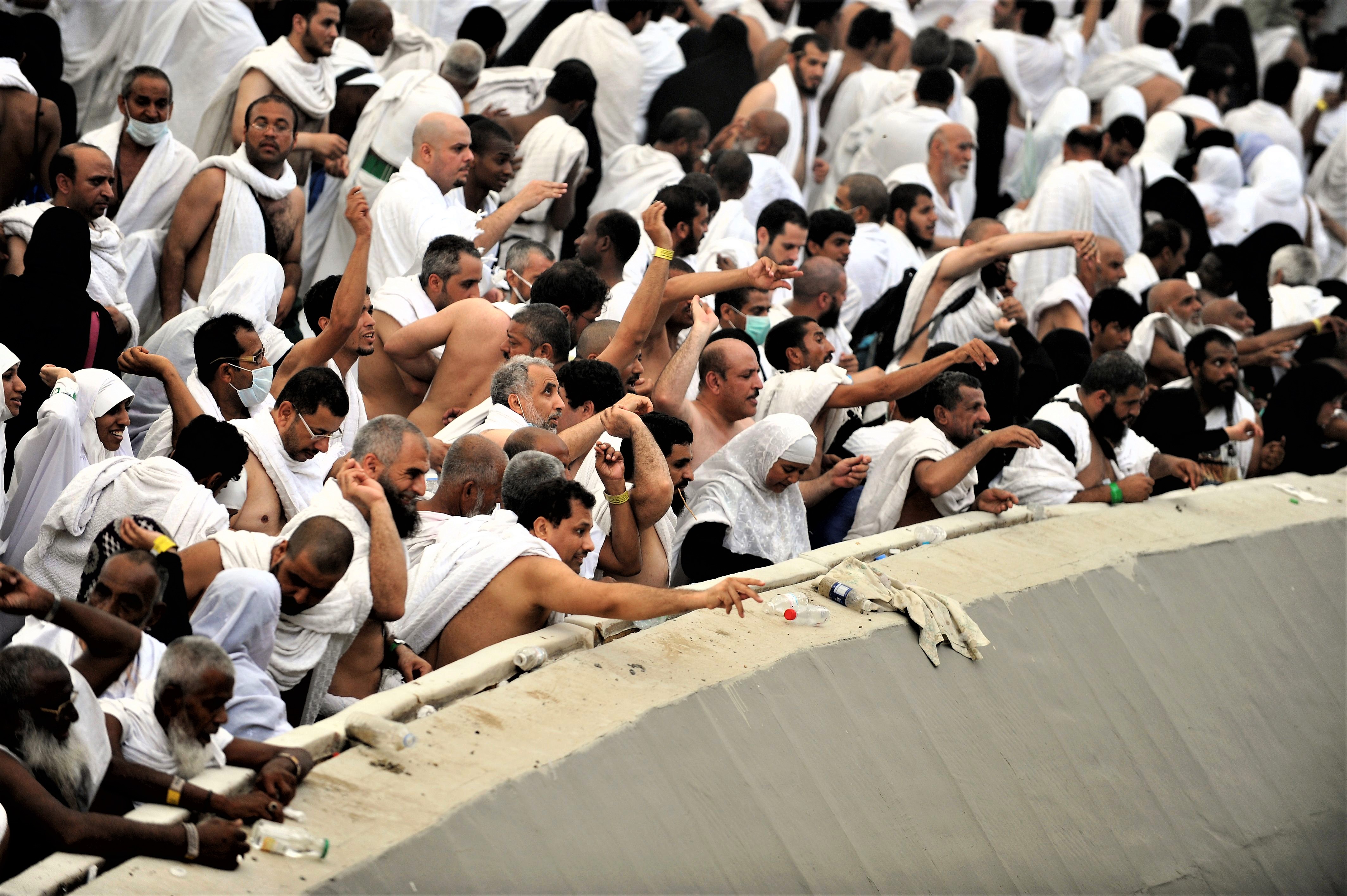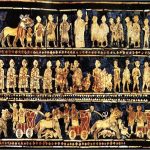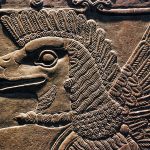One of the reasons why Muslim emperors call themselves “khalifas” or “princes of the believers” is because Allah is both the King and the owner of everything. Earthly kings in the Quran are a vile and a corrupt lot without exception: “Verily, despoiled are cities entered by kings and subservient their nobility is made and thus is the nature of kings” (Naml [Ants], 34).
Says Wikipedia: “Stoning of the Devil (Arabic: رمي الجمرات ramī aj-jamarāt, lit. “stoning of the jamarāt [place of pebbles]”) is part of the annual Islamic Hajj (pilgrimage) to the holy city of Mecca in Saudi Arabia. Muslim pilgrims fling pebbles at three walls (formerly pillars), called jamarāt, in the city of Mina just east of Mecca. It is one of a series of ritual acts that must be performed in the Hajj.”
Etymology has a problem with certain words in this text as well as in Arabic texts, Islamic and non-Islamic. The act of stoning is “rajam” from *RG with a substituted hard ‘g’ for ‘j’. “Jamarat” does not mean stones nor the act of belting but “a handful” or “many” from the root *GM. It simply means several pebbles. The English “community, combine, common”, etc., appear to be from the same root,
The Akkadian entries above provide the main function of the oracle with the local variations expected. Some of the functions of oracles were moved to Mecca. Documented cases include the oracle’s conveyed judgements in cases involving the proof of fatherhood for contested parentage of children, essential to decide legibility to inherit the father.
Clearly, Hajjis are not belting Satan or the devil as such but a known pre-Islamic oracle station not far from Mecca. By doing so they are rejecting oracles and all priests who predict future events or claim to communicate with God to obtain verdicts. Islam is clear about prohibiting priesthood and oracles. One such famous murdered oracle is Musailamah dubbed “the liar”. His wife was Sajah, a famous prophetess.

Muslim pilgrims throw pebbles at pillars during the “Jamarat” ritual, the stoning of Satan, in Mina near the holy city of Mecca, on October 26, 2012. Pilgrims pelt pillars symbolising the devil with pebbles to show their defiance on the third day of the hajj as Muslims worldwide mark the Eid al-Adha or the Feast of the Sacrifice, marking the end of the hajj pilgrimage to Mecca and commemorating Abraham’s willingness to sacrifice his son Ismail on God’s command. AFP PHOTO/FAYEZ NURELDINE
Entries 5 and 6 (raggiš, raggu) of the short Akkadian list are for the words seem aimed at “false” oracles, and therefore competitors with the established ones. The new comers are forgeries slandered by the priesthood institutions as “villains, scoundrels and traitors” in a way similar to slandering claimants to thrones and nobility.
Before oracles were housed in temples, they occupied certain humble spaces in locations marked by large stones. The more influential the oracle the bigger the stone and the the larger the ring of the stones.
The advent of the walled cities 5,000 or 6,000 years ago provided increased number of localised customers for oracles and religious services which were further developed with the Sumerian institutionalisation of religion. Prophesising became a significant service entrusted to high priests. From Sumeria, the general architectural designs of temples were copied elsewhere and continued to spread outside the land of ancient religions in most directions, or the principles exported along with Phoenician merchandise to Greece and other lands on the Mediterranean.
The image of the post is of four huge pillar stones in Al Jawf region, on the Saudi border with Jordan. The name provided is ʻmidat Arrajajil “The pillars of men” and dated “prehistoric”. Aspects of the prophesising practices are cited in the Akkadian entries. The assumption that the stones are prehistoric is plausible. Other primitive stone arrangements are located in Malta and England.
British archaeologists believe Stonehenge was built anywhere from 3000 BC to 2000 BC. Radiocarbon dating in 2008 suggested that the first stones were raised between 2400 and 2200 BC, whilst another theory suggests that blue stones may have been raised at the site as early as 3000 BC. Malta has its own “Stonehenge” said to be 4,500 years old but some believe the location was occupied 5,000 years earlier.
The name ‘midat Arrajajil’ “The pillars of men” is significant. ‘Arrajajil’ is plural for men. ‘Rajul’ (*RJl) “Man” has no other source root except *RJ (*RG). The noun is for ‘a man’ but the ancient noun for a man is different, m*Rʼ. This one is not an ordinary man so it may have meant the oracle himself.
*RJl (man) is one of several extensions of *RJ (*RG) extant in Arabic. Some of the others include:
2-*RJa: “Appeal to, plead, implore, ask for, beseech, aspire, hope for something”.
3 -*RJb: “Fear, trepidation, dread, being scared of, fearful”. Significantly, this entry word has a description of the earliest oracle temples: “Rajbah and rajmah is a remedial step taken to prevent a productive palm tree from falling by constructing a stone wall around it, or by supporting it with a forked wooden pole”.
Arabic lexicographers on many occasions provide accurate descriptions of ancient structures or concepts without knowing what is it they are describing.
Rajab also is one of the lunar months during which sacrificial offerings used to be made but it is not clear for what exactly. The entry states that “a man who is a rajeb, is a man who glorifies his master”, but it does not explain who the master is. A line of poetry was interpreted as to mean the metaphor employed by the poet is that of the necks of horses looking like the stones upon which offerings were slaughtered. Some Arabs thought thunder was a sign of Heaven’s anger. If the sacrifices were offered out of fear it could have been to Ra from whose name Rʻd “thunder” is derived.
4-*RJd: “tremble”. However, the word is in Palestinian vernacular “to belt with stones” or for two groups to hurl stones at each other. It is possible the meaning here includes “stones” hurled from the skies or meteorite showers.
5- RJs: “taboo, commit a shameful or abominable act, abomination, atrocity, enormity, dirty, filthy, squalid , unclean, squalor, repugnant, extreme dirt, excrement, refuse, great wickedness.”
6- RJf: “tremble excessively, bewildered, to shake like a tree by strong wind or earth by an earthquake”.
7- RJm: “death, to die by stoning, cursed, like Satan, prediction, to suspect, meteorites used to belt Satans, a mark for guidance”.
An interesting suggestion is ‘rajman bil-ghaib’. The expression appears to mean a type of prophesying or predicting events in the future so it is akin to the speculation of ancient oracles.
8- RJn: “settle; take residence, to become resident in a certain place, use a place as a residence”. Ibn Sayyudoh, an Andalusian and one of two outstanding Arabic lexicographers, thought the word is a noun not a verb. It does look he was right as confirmed by no less than Sanskrit ‘rajan’ “king” but in Arabia he was just an oracle. Later on the oracles of the huge temples produced kings, or the priests of Sumeria became the priest-kings of their time.
RJn (vocalized “rajan”) is masculine. The letter’t’ is a feminine mark added at the end of nouns such as the Akkadian “ragintu: [Religion] prophetess”.
It should be noticed as well that in some cases ‘m’ and ‘n’ can be used interchangeably.
The eight extensions in Arabic are suffixed extensions (root+letter). A single prefixed extension was identified ‘S*RJ “a lantern”. The implication here is that oracles’ primitive “temples” had lanterns, some of which appear to have been the upside down shell of a tortoise filled with olive oil, plentiful in Jawf, and a wick of crushed plants twisted like a thread.
The word is important because temples functioned as providers of a continuously burning fire people can visit to light different materials then moved to homes to light fires. Some temples of oracles may have functioned the same way ensuring frequent visitors who need to light their own fires but lack the knowledge or the special stones needed to create the sparks.
The extension 6 of the Arabic short list “RJf” is interesting because the extension letter is ‘f’ which is not in the Akkadian alphabet. The entire linguistic cluster (✤*RJ⇆*JR) is sufficiently cohesive and coherent, usually a mark of Yemeni origin confirmed by the original hard ‘g’ (✤*RG⇆*GR).
Last modified: December 30, 2022



